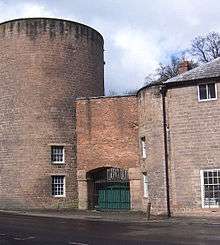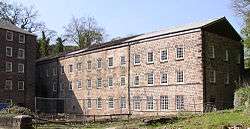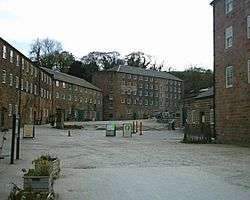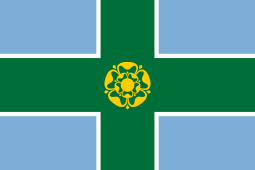Cromford Mill
|
Cromford Mill | |
 Location within Derbyshire | |
| Cotton | |
|---|---|
| Spinning Mill (Water frame) | |
| Structural system | Stone |
| Owner | Arkwright |
| Coordinates | 53°06′32″N 1°33′22″W / 53.1090°N 1.5560°W |
| Construction | |
| Built | 1772 |
| Employees | 200 |
| Floor count | 5 |
| Design team | |
| Awards and prizes and listings | Grade 1 listed |
Cromford Mill was the first water-powered cotton spinning mill developed by Richard Arkwright in 1771 in Cromford, Derbyshire, England, which laid the foundation of his fortune and was quickly copied by mills in Lancashire, Germany and the United States. It forms the centrepiece of the Derwent Valley Mills, now a World Heritage Site. The mill structure is classified as a Grade I listed building, it was first classified in June 1950.[1]
History
Following the invention of the flying shuttle for weaving cotton in 1733 the demand for spun cotton increased enormously in England. Machines for carding and spinning had already been developed but were inefficient. Spun cotton was also produced by means of the spinning jenny but was insufficiently strong to form the warp of a fabric, for which it was the practise to use linen thread, producing a type of cloth known as fustian. In 1769, Richard Arkwright patented a water frame to use the extra power of a water mill after he had set up a horse powered mill in Nottingham.[2]
He chose the site at Cromford because it had year-round supply of warm water from the Cromford Sough which drained water from nearby Wirksworth lead mines, together with Bonsall Brook. Here he built a five-storey mill, with the backing of Jedediah Strutt (who he met in a Nottingham bank via Ichabod Wright), Samuel Need and John Smalley. Starting from 1772, he ran the mills day and night with two twelve-hour shifts.[3]
He started with 200 workers, more than the locality could provide, so he built housing for them nearby, one of the first manufacturers to do so.[4] Most of the employees were women and children, the youngest being only seven years old. Later, the minimum age was raised to ten and the children were given six hours of education a week, so that they could do the record-keeping that their illiterate parents could not.

The gate to Cromford Mill was shut at precisely 6 a.m. and 6 p.m. every day, and any worker who failed to get through it not only lost a day's pay but also was fined another day's pay.
Closure and further use
The cotton mill finally ceased operation in the 19th century and the buildings were used for other purposes, finally a dyeing plant. In 1979, the Grade I listed site was bought by the Arkwright Society, who began the long task of restoring it to its original state.
The importance of this site is not that it was the first but that it was the first successful cotton spinning factory. It showed unequivocally the way ahead and was widely emulated.
World Heritage site
Today, the mill is open to the public every day, and attracts visitors from all over the world. Facilities include a visitors' centre, shops and a café. A major exhibition with working machinery is planned, with the addition of meeting rooms for educational groups, a library and a study centre.[5]
The nearby Cromford Canal towpath to High Peak Junction, and onwards towards Ambergate, is listed as a Biological Site of Special Scientific Interest (SSSI).[6]
Restoration
- Condition in 1995
The 1771 building had been reduced by two storeys in 1929, access was forbidden due to the toxic residue from the 20th century paint making usage. The later tank with its toxic sediment obscured the foundations of the 1775 mill and the breast-shot waterwheel chamber. Only one remaining mill building was usable and suitable for guided tours.
 The original 1771 mill seen on the approach along Mill Road from the village
The original 1771 mill seen on the approach along Mill Road from the village The first mill viewed from the yard in 1995
The first mill viewed from the yard in 1995 The tank over the waterwheel chamber
The tank over the waterwheel chamber The usable mill building undergoing work to replace many stone lintels and reinstate the original Georgian windows
The usable mill building undergoing work to replace many stone lintels and reinstate the original Georgian windows
- Restoration in progress 2009
 Existing three of five storeys showing the extent of the original mill. Initially there was an undershot waterwheel to the right outside of the picture.
Existing three of five storeys showing the extent of the original mill. Initially there was an undershot waterwheel to the right outside of the picture. The 1771 mill as extended in 1785
The 1771 mill as extended in 1785 The foundations of the 1775 mill ,which was destroyed by fire in 1890, with wheel chamber on the right
The foundations of the 1775 mill ,which was destroyed by fire in 1890, with wheel chamber on the right Weavers' housing, North Street, Cromford
Weavers' housing, North Street, Cromford
Buildings and structures
1771 mill

1775 mill

Waterworks

Originally the sough drained into the brook back in the village, and both powered the original mill. The sough was separated and brought along a channel on the south side of Mill Road to the aqueduct. Both then supplied the second mill. In 1785 the mill was extended to its present length with a culvert beneath for the Bonsall Brook. The sough was separated from the brook and brought from the village along the south side of Mill Lane which it crossed by way of the aqueduct to a new overshot wheel. A complicated set of channels and sluices controlled the supply to the mill, or, on Sundays to the canal, with the surplus draining into the river.
 The sluice in the mill yard used to control the water supply
The sluice in the mill yard used to control the water supply Location of the breastshot wheel for the 1775 mill
Location of the breastshot wheel for the 1775 mill The culvert carrying the Bonsall Brook under the mill extension
The culvert carrying the Bonsall Brook under the mill extension The 1771 mill showing the end of the aqueduct on the left and the hole in the wall where the wheel was located
The 1771 mill showing the end of the aqueduct on the left and the hole in the wall where the wheel was located This shuttle in the village, known locally as the "Bear Pit", controlled the water from the sough.
This shuttle in the village, known locally as the "Bear Pit", controlled the water from the sough. Cromford Pond built in 1785 as the mill pound
Cromford Pond built in 1785 as the mill pound
Housing
The mill manager has got a house on site. Whilst the first workers were brought in from outside the area, housing was built for them in Cromford.
Cromford Canal and wharf
The opening of the Cromford Canal and the associated Cromford Wharf in 1793 linked Arkwright's Mill to the major Midland and Northern cities, although use of the canal was to decline as traffic moved onto the railways.[7]
Machinery
Water frame
Initially the first stage of the process was hand carding, but in 1775 he took out a second patent for a water-powered carding machine and this led to increased output and the fame of his factory rapidly spread. He was soon building further mills on this site and others and eventually employed 1,000 workers at Cromford. Many other mills were built under licence, including mills in Lancashire, Scotland and Germany. Samuel Slater, an apprentice of Jedediah Strutt, took the secrets of Arkwright's machines to Pawtucket, R.I.,[8] America, where he founded a cotton industry. But Arkwright's success led to his patents being challenged in court and his second patent was overturned as having no originality. But by the time of his death in 1792, he was the wealthiest untitled person in Britain.[9]
Cromford Mill has commissioned a replica water frame which was installed in April 2013. Considerable problems occurred in obtaining suitable roving which had to be a low twist 0.8 count cotton. There are no companies spinning cotton today in the United Kingdom. Roving was supplied eventually by Rieter in Switzerland, who had some experimental stock. Rieter are the world's largest manufacturer of textile manufacturing machines.[10]
See also
References
- Notes
- ↑ Historic England. "Cromford Mill (1248010)". National Heritage List for England. Retrieved 1 February 2014.
- ↑ Cooper 1983, p. 65.
- ↑ Cooper 1983, p. 68.
- ↑ Cooper 1983, p. 66.
- ↑ "Cromford". Derbyshire UK: Guide to Derbyshire & The Peak District. Retrieved 5 August 2013.
- ↑ "Cromford: SSSI citation" (PDF). Natural England. 22 August 1986. Archived from the original (PDF) on 3 March 2016. Retrieved 5 August 2013.
- ↑ "Cromford Mill and Sir Richard Arkwright". Derbyshire Guide website. Retrieved 5 August 2013.
- ↑ http://www.slatermill.org/
- ↑ "Richard Arkwright (1732-1792)". thornber.net. Retrieved 5 August 2013.
- ↑ "The Cotton Rovings Saga". Sir Richard Arkwright's Cromford Mills. Arkwright Society. March 2013. Retrieved 5 August 2013.
- Bibliography
- Cooper, Brian (1983), Transformation of a Valley: The Derbyshire Derwent (New, Scarthin 1997 Reprint ed.), London: Heinemann, ISBN 0-907758-17-7
External links
| Wikimedia Commons has media related to Cromford Mill. |
- Arkwright Society - Cromford Mill - with tour information
- Cromford village website

